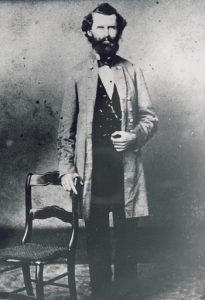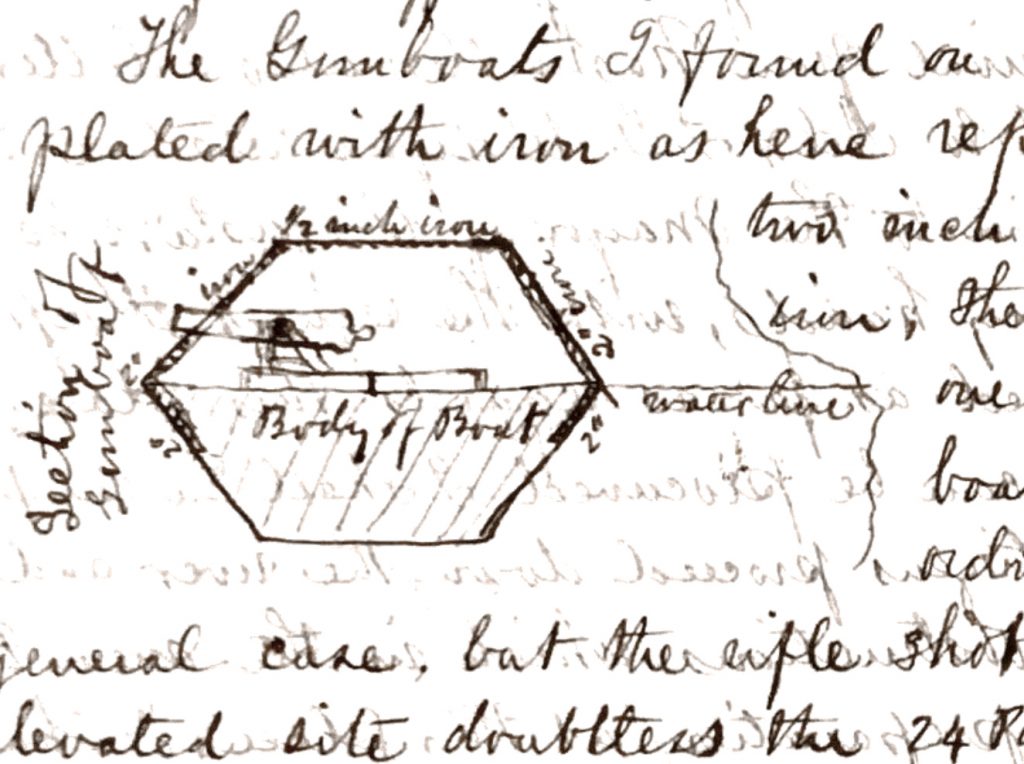George Washington Rains & The Union Gunboats at Fort Donelson

Ted Savas shares some of his research and historic documentation!
Another piece of the puzzle fell into place for me as I continue working daily on my book tentatively titled: The Other Side of the Civil War: George Washington Rains, the Augusta Powder Works, and the Failures of the Union High Command. I am about 75% finished writing. I thought some of you would find this interesting.
The critical Battle for Fort Donelson unfolded 159 years ago. I have been carefully piecing together where George Washington Rains was each day of the war.
Rains (who operated much of the time out of Nashville early in the war) raced out of Tennessee to Augusta, GA, on February 18 and immediately wrote an intriguing letter to General Robert E. Lee, who was then commanding along the south Atlantic seaboard. Its purpose was to discuss how best to defend the Savannah River and Augusta.
He included details about what he had learned observing Union gunboats “I found on the Western waters.”
 The only time these enemy riverine craft crept close enough for him to have examined them personally during actual combat was the middle of January (when the USS
The only time these enemy riverine craft crept close enough for him to have examined them personally during actual combat was the middle of January (when the USS
Lexington and Conestoga lobbed shells toward Fort Henry from a long distance), and on February 14, during Flag Officer Foote’s battle on the Tennessee River against Fort Donelson.
Rains never explicitly stated precisely when or where he saw them, but he was close enough to draw and describe extraordinary details about ironclad gunboats, including the thickness of their iron, the effect of varying weights of shells fired against them, and the elevations required for those shells to be effective.
His letter (which was essentially a field report) included, among many other things, a comparison of the effectiveness of Confederate artillery. “Fort Henry,” wrote Rains, “. . . was on a level with the water, hence its 24 pdr guns made little impression,” while “Fort Donelson was on higher ground, and thus its shot were much more effective; indeed, three of the six iron clad gunboats were badly crippled.”
Since the USS Lexington and Conestoga were “timberclads,” and did not receive return fire from Fort Henry, Rains could only have witnessed the historic fight at Donelson on February 14.
He also informed Lee that these gunboats could be penetrated by rifled 24-pounders fired from an elevated position because the tops of the boats were but thinly covered, in contrast to the two-inch iron plates composing the sides.
He also relayed accurate information that would have been impossible for him to have learned through other sources by the time he wrote his letter unless he had witnessed some or all of what he described.
Why was this so important?
The fall of Donelson led to quick loss of Nashville and the only saltpeter and vibrant powder mill. Augusta was along the Savannah River. Rains finally realized the true power of the Union ironclad gunboats. If Savannah fell, they could steam up the river and destroy the large new powder works he had spent many months designing and building, and the one soon to be the only significant source for the entire Confederacy.
Rains had openly scoffed at the Union warships darting about the sea islands of Georgia. After what he witnessed and the fall of Donelson, they gave him nightmares.
Great article, I look forward to your upcoming book on Rains. Growing on the DelMarVa Peninsula and not far from where the DuPont Powder works were I’ve always had a passing interest in this aspect of the war. My studies of Delaware Confederates unearthed Peter Baudy Garesche (born in Wilmington, De) who made powder for the Confederacy as well. I find it interesting how gentlemen like Rains and Garesche who were so vital to the Confederate War effort are now largely forgotten.
Thanks Mark. Part of my mission is to introduce the real player(s) of the war–the ones who made it all possible. And the monumental cock-ups made by the North that not 1 of 100 readers have even considered.
Mark, my brief article on Peter Garesche is in the Summer 2023 issue of “America’s Civil War”
Engineer officers were highly valued within the Confederacy. Early in the war, in the Western Theatre, there were:
Joseph Dixon, USMA 1858, present at Forts Henry, Heiman and Donelson, involved primarily with positioning of guns and entrenchments. Killed at Fort Donelson on 13 FEB 1862 by round fired from USS Carondelet.
Jeremy Gilmer, USMA 1839, present at both Fort Henry and Fort Donelson and wounded at Shiloh. May have had involvement in placing torpedoes (Fort Henry and Fort Columbus) and positioning of guns (Forts Columbus, Henry and Donelson).
Isaac Newton Brown, former U.S. Naval Officer, in CSN. Likely present at Fort Columbus and Fort Henry, involved in placing torpedoes. Lieutenant Brown met Dr. A. L. Saunders, Confederate torpedo inventor, in Memphis; and also had frequent meetings “back east” with Matthew Fontaine Maury. Isaac Brown converted several river craft for military use on the Tennessee River (and had ALMOST completed ironclad CSS Eastport on that river before her capture.) Lieutenant Brown completed and commanded CSS Arkansas, renowned for her breakout and subsequent defense of Vicksburg in July 1862.
As for George W. Rains, USMA 1842, I have no information on him, and cannot confirm nor deny his presence in Kentucky and Tennessee. However, in relation to ironclads and Fort Donelson, there are several options for gaining intelligence:
A spy working on the boats in Illinois or Missouri passed along details;
Someone (possibly George Rains) was across the Cumberland River from Fort Donelson and watched the action from there, in company with Scott’s Louisiana Cavalry, on February 13 or 14 (ironclad action during both days);
As suggested, George Rains may have been present at Fort Donelson, 13 and/or 14 FEB 1862 and made his escape with Major General John Floyd back to Nashville when that officer and his Virginia troops (and Jeremy Gilmer) departed just before Buckner surrendered to U.S. Grant.
Don’t forget Tilghman (West Pointer turned railroad/civil engineer) and Bushrod Johnson (West Pointer turned math professor). The State of Tennessee sent Bushrod Johnson, with his West Point degree, among some other civil engineers/surveyors to check out locations for what became Forts Henry and Donelson. There was no real organization and a lot of time was wasted in getting these forts sited and constructed. A “What If” for Chris’ new series.
Lyle Smith, thanks for your additional information.
The Athens Post (Athens Tennessee) of 21 FEB 1862 page2 has much of interest regarding the capitulation of Fort Donelson; and includes details of Lieutenant Dixon’s death there, beginning Column 2 (although the date of death given is incorrect.) Same page 2 also has details of the surrender of Fort Henry; the subsequent advance of Federal timberclads up the Tennessee River; and “the bridge destroyed at Danville” mentioned column 6 is of interest, because destruction of this bridge at Danville Tennessee, 10 miles south of Fort Henry severed direct connection of Memphis to Nashville, and Memphis to Bowling Green; and most importantly, the loss of this crucial bridge over the Tennessee River destroyed the direct, rapid communications link connecting Fort Columbus on the Mississippi River to Fort Henry to Fort Donelson to Bowling Green: the ability to rapidly shift Rebel soldiers from one end of the line to the other being lost, Fort Columbus was turned, and subsequently abandoned. [Above newspaper available in full at LOC collection “Chronicling America.”]
Thank you for this. Unsure why you are questioning whether Rains was there. I have his letter to Lee and his drawing from the letter.
This looks like it’s going to be a great military history read. What an interesting guy to follow around throughout his Civil War.
Thank you. I have about two-thirds of it written now and it is I think going to be very eye-opening for the Civil War community.